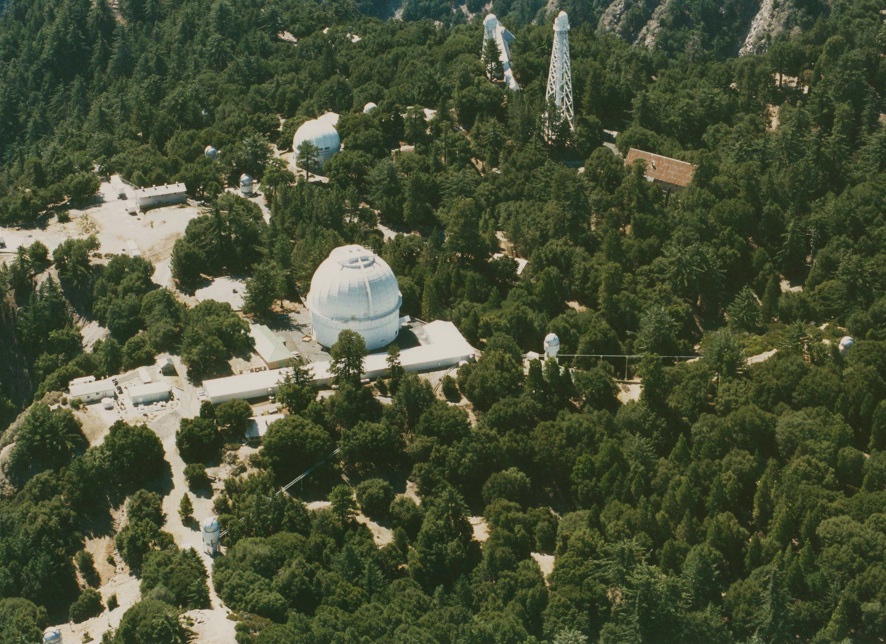User Tools
Sidebar
This is an old revision of the document!
Table of Contents
Center for High Angular Resolution Astronomy
[[http://www.chara.gsu.edu/CHARA/|The CHARA Array ]]
Diameters of six M dwarfs measured by CHARA, when combined with results from other interferometers and for eclipsing binaries, show a departure from theory that becomes more apparent with increasing metallicity. Thus, current models may overlook some additional opacity source.
The first direct measurement of an exoplanet diameter was accomplished by CHARA measurements of the angular diameter of the host star in the exoplanet transit system HD 189733.
A 4-telescope beam combiner developed for CHARA at the University of Michigan is producing CHARA’s first stellar images. This new program is directed at imaging binaries, rotationally oblate rapid rotators, and stellar disks.
Overview of the CHARA Array
Georgia State University’s Center for High Angular Resolution Astronomy (CHARA) operates an optical/near-IR interferometric array on Mount Wilson, California. The CHARA Array consists of six 1-m aperture telescopes arranged in a Y-shaped configuration yielding 15 baselines from 33 to 331 meters. These include several of the longest O/IR interferometric baselines yet implemented and permit
resolutions for stellar diameter measurements, conservatively defined in terms of reaching the first null in visibility, of 1.6 and 0.4 mas
(milli-arcseconds) in the K and V bands respectively. For binary star studies, these limits are 0.8 and 0.2 mas.
The major elements of the Array (ten Brummelaar et al. 2005) consist of light collecting telescopes, vacuum light beam transport tubes, optical path length delay lines, beam management systems, and beam combination systems.
Light Collecting Telescopes – Each of the six telescopes is an afocal beam reducer that injects a 12.5-cm output beam into the vacuum transport tubes. The primary and secondary substrates are of low-CTE materials. Typical primary/secondary mirror performance is 0.035 waves rms at 633 nm and, when perfectly aligned, can achieve a Strehl ratio of 0.93. The secondary mirror is actuated for adaptive tip/tilt compensation. The custom designed mounts, are exceptionally stiff and massive (23,000 lbs) for interferometric stability and the structure is designed to maintain temperature-independent focus. The telescope enclosures are comprised of two concentric cylinders each of which can be raised and lowered to provide high-throughput passive ventilation. Telescope and enclosure control electronics are located in adjacent cement block bunkers to avoid heat production within the enclosures. An example telescope and enclosure are shown in Figures 1 and 2.
Vacuum Light Beam Transport Tube – The final mirror in the telescope optical train injects the collimated beam through an optical window into a vacuum tube for transport to the Array’s central beam combination facility. Each Array arm (20,000 liters) can be pumped down to an operating level of ~1 Torr in about an hour.
Optical Path Length Compensation – Maintenance of zero optical path length difference is accomplished at the CHARA Array in two stages. The first occurs in vacuum and employs six parallel systems (referred to as the “Pipes of Pan” or PoP’s). Remotely actuated mechanisms move mirrors to select appropriate delay segments. Upon exiting the PoP’s, the beams leave vacuum and are injected into the continuous delay lines by a pair of “periscope” mirrors. The “optical path length equalizers” (OPLE’s) were provided to CHARA under a contract with JPL. The OPLE’s incorporate cat’s-eye retro-reflectors, each on steel rail pairs 46 meters in length. A four-tiered nested servo system, with feedback from a laser metrology unit, provides path length tracking with an rms error of 10 nm. The combination of the PoPs and the OPLEs gives a controlled delay in each telescope of up to 270 m. A view of the OPLE system is shown in Figure 3.
Beam Management – The beams emerging from the OPLE’s are reduced to a final diameter of 1.9 cm by a recently improved, two-element “beam-reducing telescope” (BRT). The beams then pass through the “longitudinal dispersion corrector” (LDC) that corrects for unequal air paths. Finally, the “beam sampling system” (BSS) separates visible from IR light at the 1-μm boundary and turns the two beams through 90° along parallel paths to the visible and IR beam combiners. The BSS assembly moves on a precision stage so as to serve as a switchyard for selecting baseline pairs to be directed to the beam combiners.
Beam Combination – Through formal, collaborative agreements between CHARA and several institutions, the beam combination capabilities of the Array have been very significantly expanded beyond what could otherwise have been created by CHARA staff alone. The “CHARA collaboration” presently includes groups from l’Observatoire de Paris, the University of Michigan, the Laboratoire d’Astrophysique de l’Observatoire de Grenoble, the University of Sydney, the Michelson Science Center at Caltech, and l’Observatoire de la Côte d’Azur. Each of these groups has contributed to the development of the Array, primarily through the design and installation of powerful beam combiners.
The Beam Combining Laboratory (BCL) contains four, soon to be six, separate beam combiners with complementary regimes of wavelength, sensitivity and measurement precision. The Array control system is capable of running up to three of these in parallel, doubling, and sometimes tripling, the number of scheduled programs. While this approach is very demanding of the Array infrastructure, there is no other way to provide sufficient observation time to meet the demand for the CHARA Array. The present mix of beam combiners, shown in Figure 4, includes:


